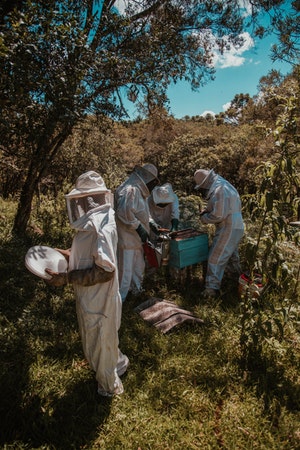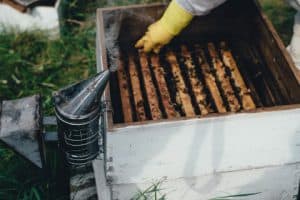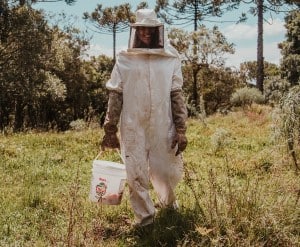Beekeepers don’t seem bothered by being exposed to a swarm of bees. Beekeepers help to save these helpful creatures while saving humanity too, since bees are the most important pollinator of food crops in the world. These professionals educate themselves and others about what makes bees important for life and why they are worth keeping.
Why don’t bees attack beekeepers? They actually do. Most people might think that beekeepers are exempted from bee stings. But the truth is, they aren’t. Bees can be aggressive because factors in your behavior, nectar dearth, alarm pheromone & bananas, as well as weather.
Bees sting beekeepers because of some specific reasons. To avoid being stung by bees, there are strategies that beekeepers can practice. Most beekeepers choose to have a tolerance to bee venom. Moreover, there are situations where bees just seem to attack. So I tackled some of the things you can do during those situations later in this article as well as the secret to treating bee stings.
Table of Contents
Spoiler Alert, They Do Sting Beekeepers!
Unfortunately, beekeepers also get stung by bees, and it is only natural. Bee stings are impossible to avoid because they spend so much time in places where bees are around. It is just one of the risks they are exposed to, in exchange for taking care of bees. The frequency of being stung by bees depends on the types of bees are being kept and their number.
Reasons Why Bees Attack You
Beekeepers Behavior

Bees that are being robbed of honey naturally become aggressive to defend their stock. It is the reason why beekeepers encounter a cloud of bees circling a hive when they collect honey in the beehive. Moreover, beekeepers are not the only one who rob bees. Bees rob each other too.
When you accidentally snap a frame apart resulting in a loud crack, bees can go full alert and might attack you. Sudden vibrations can make bees wary, so make sure to be careful when handling things around their hives. Making sudden movements can also make bees attack you. It is why swatting at them when they explore your clothing and hands is a risky thing to do.
Nectar Dearth
Nectar dearth is the scarcity of the sources of nectar, which is mostly a result of the transition of seasons where flowers are dry. For bees, it is when there is less food to harvest. So, their solution is to rob each other that leads to aggression.
Alarm Pheromone and Bananas

When a beekeeper is stung by a bee, the bee will release an alarm pheromone to call other bees and make them behave defensively. Alarm pheromone has the same smell as bananas, so beekeepers are advised to avoid using products that are banana scented as well as eat bananas before going to beehives.
Weather
Weather is also associated with the aggression of bees. In wet and summer seasons, specifically, when the humidity and heat are high, bees become irritated, so make sure to keep the ventilation of their hives well set.
Strategies of Beekeepers To Avoid Stings
Smoking

Smoking bees are the most common strategy of beekeepers to avoid bee stings, mainly when they harvest honey. Smoke can help to calm bees by preventing them from smelling the alarm pheromone and triggering them to their natural survival response.
When bees smell the smoke, they interpret it as a life-threatening alarm like the forest or their hive is on fire. As a result, they leave their home.
Beekeepers use smoking for generations because it is safe for the health of bees. However, beekeepers must be careful when smoking, especially with the tools they use because incredibly high temperatures can melt the wings of bees. Pine cones, cartons, wood chips are the common safe materials used by beekeepers as fuel.
Wear Light and Pale Colored Clothes
Bees perceive colors different than how we do, and they are attracted to particular colors, especially those that are bright. Dark colors like red and black make bees aggressive because they interpret them as skunks, bears, and their other natural predators. The wearing of dark clothes might not trigger bees to sting you right away, but since it makes them defensive, making even the smallest mistake while wearing such colors will cause them to attack.
Wear Suit

Protective clothing like bee suit, gloves, and veils is another strategy to avoid bee stings. You can find different suit design for beekeepers in the market which you can observe is white-colored and has varying level of protection or coverage. Some bee suits have a design that can cover only the arms and torso, and most suits can cover the entire body. Unfortunately, these protective clothing can’t provide a 100% protection against bee stings. Bees are still able to sting you through the suit in some instances, but it dramatically reduces the chance.
Please see our other article for more information on suits: https://schoolofbees.com/safest-beekeeping-suits-for-beginners/
Spray Sugar Water
Beekeepers who will tend a new package of bees are not recommended to use smoke because it will send a wrong message to the bees that their new hive is dangerous for them. So in this case, use sugar water instead and spray it to the package. It will make bees divert their attention to cleaning themselves than defending their territory.
Things To Do When Being Attacked By Bees
Being stung by bees is different by being attacked by a swarm of bees. If the latter happens to you, here are some of the things to do:
Run

Swatting bees and staying still is not advisable when a swarm of them is attacking you. It will only give them time to call more bees, which makes the situation more dangerous.
Don’t Seek Protection in Water
Seeking protection in the water won’t help you avoid the sting of a swarm. When you gasp for air, they will cover your face and sting you.
Remove Stringers from Your Skin
When the attack is over, remove any bee stingers from your skin immediately. Honey bees are the most common type that beekeepers take care of, and they are the only insects that leave their stinger in the skin. The stinger comes along with the venom sac which will continue to pump venom, so it is important to pull it out. Simply scrapping off using your fingernails can remove honey bee stingers.
Seek Medical Attention
If the attack left you with stings, go to a clinic or hospital for treatment, especially if you experience swelling and hives around your face or throat accompanied by difficulty in breathing. Some people might handle bee stings, but those who have allergies to bee venom, even one bite can put them into danger.
Tolerance To Bee Venom
A new study found out the major allergen in bee venom can promote immunity and protection against allergic reactions that can further arise because of the toxin. Some beekeepers can tolerate even a hundred of bee stings, and in fact, they get stung by bees intentionally to build up their tolerance. However, people who have an allergy to bee venom can experience a high level of danger even with a single sting, primarily when insect venom anaphylaxis occurs.
VIT or venom immunotherapy is a solution that medical experts use to treat sting anaphylaxis linked with a promising success rate of 75 to 85 percent with bee venom. While it won’t help to treat bee stings and have a 100% bee venom tolerance, it helps to reduce the danger of further allergic reactions.
Beekeepers Secret To Treat A Bee Sting
The home treatment utilized by beekeepers can be enough to treat a bee sting. However, receiving multiple stings as well as having an allergic reaction needs immediate medical attention and treatment. If you observe yourself with the following symptoms, seek medical care right away and always consult a medical professional before trying these remedies:
- Pale skin
- Hives
- Severe itching
- Rapid pulse
- Diarrhea
- Dizziness
- Swelling of the throat and tongue
- Loss of consciousness
- Difficulty breathing
- Nausea and vomiting
Here are some of the home remedies you can use to treat bee sting at home:
Honey
Apply an ample amount of honey to the affected area then cover it with cloth or bandage, leaving it for one hour. It can help with the pain and itching of the sting and assist its healing.
Apple Cider Vinegar
Soak the area of your skin stung by bees for a minimum of 15 minutes. Apple cider vinegar can neutralize bee venom.
Baking Soda
Put a baking soda paste thickly in the sting area and cover it with a bandage. Leave it for 15 minutes and if needed, apply again. Baking soda can reduce the swelling, pain, and itching caused by bee stings.
Meat Tenderizer
Papain, an enzyme found in meat tenderizer can help to disintegrate the protein that triggers itching and pain of bee sting. To use it, mix four-parts of water and one-part meat tenderizer then apply to sting area for a half-hour.
Herbs and Oils
Herbs carries particular properties that aid in healing wound and relieve bee sting symptoms like pain and itching. Try using aloe vera, lavender essential oil, calendula cream, witch hazel, and tea tree oil to treat your bee stings.
Ice
One of the traditional bee sting treatments is the use of ice for applying a cold compress to the affected area. It reduces swelling and pain caused by bee venom.
Conclusion
Beekeepers play an essential role in protecting bees and collecting high-quality honey for human consumption. However, they are exposed to bees most of the time, so a bee sting is inevitable. Following the strategies above can’t always help beekeepers avoid being stung, but they can help to reduce its frequency. Keeping home remedies for treating minor bee stings at home is also a great practice, but if allergic reactions arise, seek medical attention right away.
